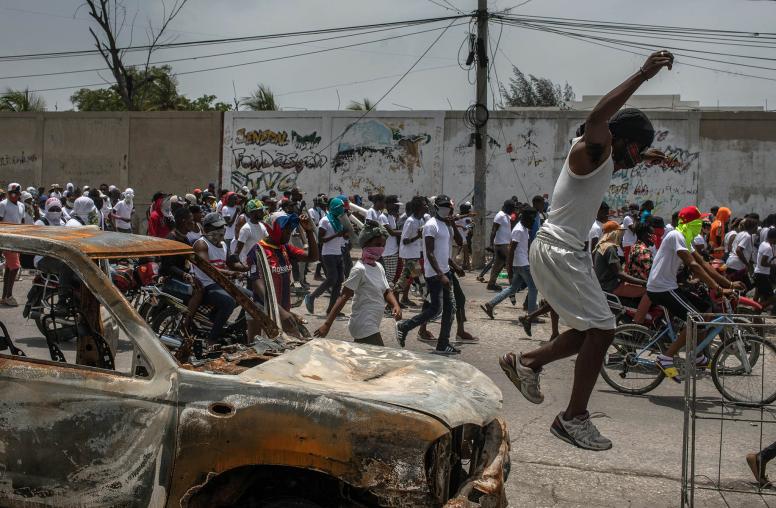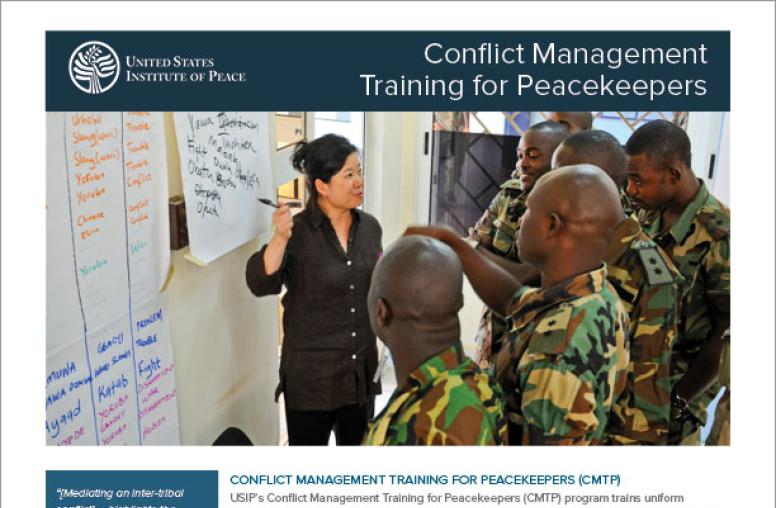Global Fragility Act: A Chance to Reshape International Security Assistance?
By building on aid effectiveness principles, the U.S. can forge a global architecture for security sector assistance.
When the new U.S. administration gets to work, domestic priorities will be front and center on the agenda. Preventing state fragility and violent extremism abroad may seem less urgent. But implementing the Global Fragility Act (GFA)—which aims to fulfill those goals—should remain a top priority. Successfully advancing the GFA would directly benefit U.S. national security and help establish a more values-driven foreign policy. To this end, the United States should work with allies to create a global architecture for security sector assistance built on principles of aid effectiveness adapted from development financing. A U.S.-brokered international consensus on security assistance would help stabilize fragile states, prevent violence, and increase the value of dollars spent on the GFA.

Rethinking SSA that’s ‘Stuck in the Past’
The GFA marks a new approach in U.S. policy toward fragile states. It calls for all parts of the U.S. government to work out a coherent strategy and repurpose foreign assistance toward averting conflict and violent extremism. To achieve these goals, the GFA dedicates $1.15 billion over a 10-year time horizon for programs in five countries or regions. The GFA implementation strategy directs the State Department, the Department of Defense, and other agencies to promote meaningful reforms of security and justice sector institutions that increase legitimacy and reduce corruption. They should also work together to support legitimate, rights-respecting security institutions, capable of countering threats to stability, such as terrorist groups.
A shift in U.S. security sector assistance (SSA) toward advancing the good governance of armies and police is necessary. In Africa, a 2018 RAND Corporation study revealed that with the notable exception of a correlation to positive outcomes in U.N. peacekeeping contexts, SSA has been highly inefficient and may have achieved the opposite of its objectives: U.S. assistance was not correlated with reductions in civil wars, terrorism, or state repression. In Afghanistan, the U.S. allocated $83 billion in security assistance since 2002, but the Afghan army and police have failed to subdue the Taliban—the group now exercises control or influence in at least half of the country. In Iraq, despite billions invested in training and equipment, local security forces disintegrated quickly in the face of the Islamic State in 2014 and remain dependent on U.S. assistance. The result is an approach to SSA that has been labeled “stuck in the past” and fails to efficiently build allies’ and partners’ capabilities.
The same problems undermine European SSA initiatives. In West Africa, these initiatives focus primarily on expensive efforts to help local security forces achieve military victory against violent extremists. This strategy may strengthen partner forces’ operational effectiveness in battle. But by neglecting security sector governance, European SSA may also make them less legitimate. France’s Operation Barkhane in Mali costs $800 million per year, dwarfing the EU’s security sector reform programs. However, Malian forces are prone to human rights violations, and successfully staged a coup d’état in August 2020.
The GFA is thus a chance for the U.S. security assistance to break with the past. In addition to repurposing its own instruments and approach, the United States should strive to create global norms for effective security assistance. Presently, there is no common framework or forum for Washington and its allies to decide what SSA initiatives to finance; how to find out which policies work and which have failed; or simply to have a data-driven debate on obstacles to success and lessons learned. International security sector assistance thus suffers from a massive deficit in global governance. The effects are perpetual cycles of violence, instability, and state fragility—precisely the problems that the GFA seeks to address.
Applying Aid Effectiveness Principles to Security Assistance
In the development sector, bilateral donors come together within the Organization for Economic Cooperation and Development’s (OECD). OECD’s Development Assistance Committee (DAC) collects and analyzes data on official development aid flows, and works to improve development cooperation. The OECD also promotes initiatives such as the 2005 Paris Declaration on aid effectiveness, which led to an international consensus on the four principles of aid effectiveness: aligning development aid to country-driven priorities; a focus on measurable results; inclusive partnerships based on the complementarity of actors; and transparency and accountability. A global architecture for SSA could be modeled after them, along with an additional principle which we propose.
1. Alignment with country priorities
The Task Force on Extremism in Fragile States emphasized that the United States must mitigate the risk that security cooperation and assistance provoke recruitment into extremist groups, empower repressive governments, or fail to improve operational capabilities of local security forces. Doing so is not a technocratic fix, however. It entails a deep understanding of civil-military power dynamics in fragile states that would help prevent U.S. security assistance from being undermined by elite capture or reforms based on empty promises. The United States should align its security assistance to country-driven priorities only when partner governments show credible commitments to improving security governance. Intelligence collection and analysis to verify the intent and feasibility of partner government commitments could help assess the reliability of country priorities and determine if local power dynamics are favorable to creating windows of opportunity for security sector reform (SSR).
2. Results-based financing
The GFA implementation strategy calls for the U.S. government to establish a monitoring framework that allows for systematic progress reviews, data-driven assessments, and clear metrics to determine progress. Developing this monitoring framework into an international regime could help define the indicators for a global performance-based financing fund for SSA in fragile states. This financing instrument would reward expensive capital investments in military equipment only if security sector governance and reforms are well-implemented. The type and amount of support would be linked to the quality of security sector governance in fragile states—a recommendation which the Task Force called a graduated approach to U.S. security assistance and cooperation. A global financing facility for SSA to which the Global Fragility Fund mandated by the GFA contributes could help start this process.
3. Inclusive Partnerships
According to the OECD, development partnerships should involve broad coalitions of actors who play complementary roles in society—from parliaments and NGOs, to multilateral development banks and the private sector. But innovations in digital technology enable a more ambitious agenda: the direct contribution of citizens in monitoring development projects. Free and open software such as Kobo Toolbox is used by humanitarian and development agencies to monitor project implementation in near real-time through phone-based solutions that geo-tag activities. The same approach could be used to monitor perceptions of insecurity and verify if security sector governance and reform initiatives lead to tangible results for people and communities. A global financing instrument for SSA could support new tools such as a data-driven citizen engagement strategy to monitor security sector reform and improve citizen-responsive governance.
4. Transparency and accountability
Promoting the transparency and accountability of security aid flows would mean keeping them on recipient country budgets and publishing data on what is being spent, by which agencies, and for what programs. This would help diminish opportunities for corruption within the armed forces that grow when SSA funding is kept off-budget. As a recent USIP report on the GFA notes, corruption undermines the ability of military, police, and intelligence to respond to threats effectively. Washington should condition expensive “train and equip” programs implemented in fragile states on credible commitments to promote good governance of the security sector.
5. Affordability of Security Assistance
Transparency and accountability help reinforce another key principle: security assistance should be affordable. Prior to Mali’s 2020 coup, total spending on security assistance by partners reached $2.1 billion according to one estimate—or about 10 times the average defense spending of G5 Sahel countries (Burkina Faso, Chad, Mali, Mauritania, and Niger). The cost of replacing all foreign security support from France, the U.N. and EU would amount to 75 percent of current government revenue. Here too, the development sector may offer a solution—security sector public expenditure reviews, which assess the affordability, efficiency, and transparency of defense and police. For example, spending scenarios for defense and police linked to macro-fiscal parameters would help anchor SSA within realistic estimates of fiscal space and enlarge the scope of potential partners to organizations such as the International Monetary Fund (IMF).
Geopolitical Implications
Critics might argue that a major paradigm shift in SSA could harm U.S. efforts to counter China and Russia by complicating U.S. partnerships amid increasing great power competition. But, Russia’s approach to security assistance relies on coopting the political and economic interests of local elites, while China does the same through infrastructure projects financed by the Belt and Road Initiative. Defense Department insiders and experts have noted that SSA planning and execution should account for Russian and Chinese tactics. Consequently, the advancement of security sector governance and the rule of law as called for by the GFA could also help counter the influence of geopolitical competitors.
The GFA implementation strategy is not only an opportunity to rethink and reshape U.S security assistance, but also to create a global consensus on support to the security sector in fragile states. A U.S.-led global framework for security assistance—supported by an international financing mechanism—would help avoid past mistakes and build better defense and security institutions in fragile states, while making the most of taxpayer dollars. Effective, self-reliant security, and accountable armies and police have a better chance of preventing conflict and violence. Ultimately, this makes them more reliable partners for the United States.
Paul M. Bisca is a security and development advisor to international organizations and co-author of “Securing Development: Public Finance and the Security Sector.”



